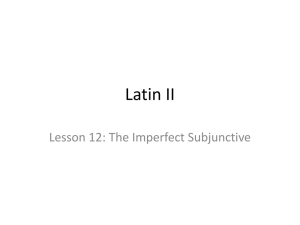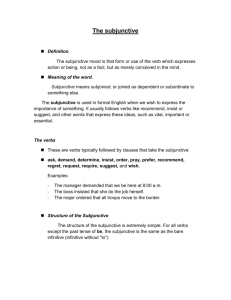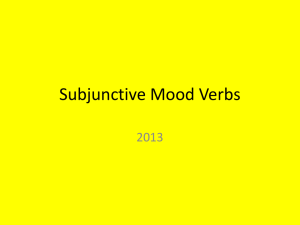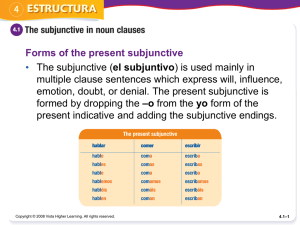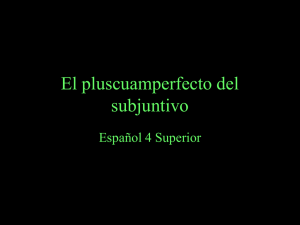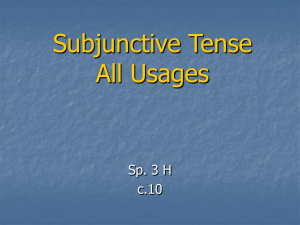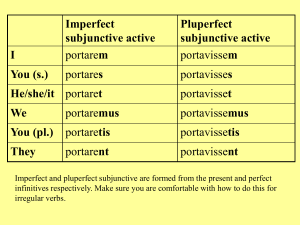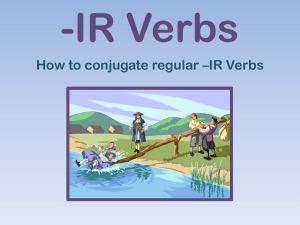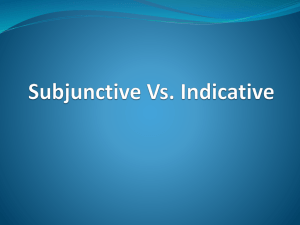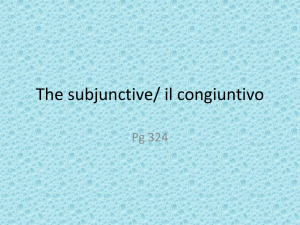Present Subjunctive
advertisement
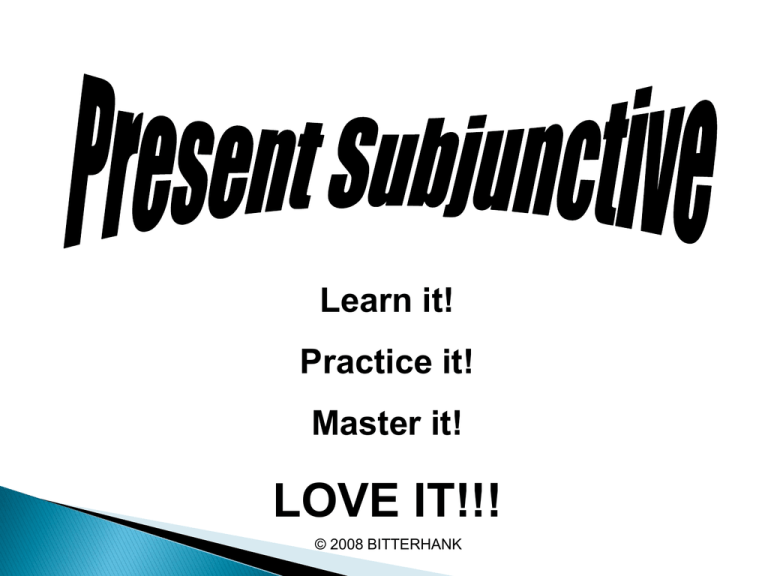
Learn it! Practice it! Master it! LOVE IT!!! © 2008 BITTERHANK Brief Description Setup Words Verb Formation Constructing a Sentence Final Thoughts Practice The present subjunctive is a “mood” in Spanish. It is used to express uncertainty, doubt, emotional reaction, or future actions. The subjunctive conjugation of a verb is usually used in the second part of a sentence. For example, I may say, “I want you to study.” You may or may not do it, so the word “to study” would be conjugated in the present subjunctive. The subjunctive is the opposite of the indicative mood, which has all of the tenses that you already know. The indicative is used to express what is completely true or false, what is clear, or what is concrete. This module is only an introduction to the concept of the subjunctive. Its uses are vast! Home These words, used in the first clause of a sentence, set up the use of the subjunctive in the second clause. What is said after these words may or may not happen, so the conjugation of the second verb is not the present tense as you know it. querer (ie) = to want sugerir (ie) = to suggest recomendar (ie) = to recommend insistir en = to insist esperar = to hope ojalá que = hopefully / it’s hopeful I may want you to do something, but you may not do it. I may suggest that you read the rest of this, but… Your parents might recommend that you wash the dishes right away, but you might not do it at all. A friend may insist that you go with him, but you might not want to go. You might hope that something happens, but it may not happen. Home Colby This site is AWESOME! It even has sound. It has the present subjunctive and so many more topics for practice. Spaleon.com This site can also be used for other verb tenses. Bowdoin Look for “subjuntivo”. There are many other good exercises. Quia.com Under “subcategory”, look for “subjunctive” or “subjuntivo”. Home To set up the subjunctive there are three things that must be in the sentence. 1. One of the setup words 2. The word “que” 3. A subject change Sugerimos que ellos duerman más. Setup word: we suggest ellos: que: that subject change “duerman” = they sleep This is the subjunctive conjugation. They may or may not do it, even though we suggest that they do it. Recomiendo que tú hagas la tarea. Setup word: I recommend tú: que: that subject change “hagas” = you do This is the subjunctive conjugation. You may or may not do it, even though I recommend that you do it. Ella quiere que yo viva en España. Setup word: she wants yo: que: that subject change “viva” = I live (subjunctive) I may or may not do it, even though she wants me to. Note: In English this would be, “She wants me to live in Spain. In Spanish the infinitive is not used, even though it sounds like it should be. Subjunctive in Context In the examples that you see on the next slide, remember that the subjunctive is used in the second half because it may or may not happen. If this sounds strange to you, it’s because we don’t recognize the present subjunctive in our spoken English. Please also remember that the examples that use “querer” are going to sound different in their English translations than the others. Consider the following example. I want you to go to the store. Many students want to say: Te quiero ir a la tienda. The right translation is: Quiero que vayas a la tienda. The red example is not Spanish grammar, even though it sounds or looks like it should be. Use the subjunctive after querer with que and a subject change. Ojalá que entiendas bien esta lección. (Hopefully you understand this lesson.) Insistimos en que vosotros regreséis a tiempo. (We insist that you all come back on time.) Mi madre quiere que pongamos la mesa. (My want wants us to set the table.) ¿Sugieres que yo se lo dé a ellos? (Do you suggest that I give it to them?) ¿Esperáis que los Brown ganen el Super Bowl? (Do you guys hope that the Browns win the Super Bowl?) Home Verb Formation Menu The Basics Stem Changing Verbs Spelling Changes Irregular Verbs Home In order to conjugate a verb in the present subjunctive, you have to know well the conjugations of the present indicative (the present tense that you already know). First: Use the “yo” form of the verb in the present tense. hablo Next: vivo com_ viv_ Drop the ‘o’ habl_ Last: como Add an opposite ending. This means for -ar verbs, use -er endings, and for -er/-ir verbs, use -ar endings. hable coma viva Subjunctive Verb Endings -ar Verbs -er Verbs -ir Verbs -e -emos -a -amos -a -amos -es -éis -as -áis -as -áis -e -en -a -an -a -an Examples of Regular Verbs caminar camine compartir caminemos comparta compartamos camines caminéis compartas compartáis camine comparta caminen comprender comprenda comprendamos comprendas comprendáis comprenda comparendan compartan It doesn’t really mater what the “yo” form of the present is. If there is a stem change or other spelling change in it, the change will be seen in the subjunctive. Consider the following. Infinitive Present Indicative Present Subjunctive acostarse (ue) me acuesto me acueste decir digo diga divertirse (ie) me divierto me divierta dormir (ue) duermo duerma entender (ie) entiendo entienda poner pongo ponga preferir (ie) prefiero prefiera Verb Menu reírse (i) río ría venir vengo venga -ar and -er stem changing verbs still have no stem change for nosotros and vosotros in the present subjunctive. However, certain -ir verbs do. Note the following. poder (ue) acostarse (ue) preferir (ie / i) pueda me acueste prefiera puedas te acuestes prefieras pueda se acueste prefiera podamos nos acostemos prefirimos podáis os acostéis prefiráis puedan se acuesten prefieran A note about -ir verbs Stem changing verbs ending in -ir have multiple stem changes. They are the only verbs that have stem changes in the preterit and present participle. Whenever you see two choices after an infinitive the first is for the present indicative and four conjugations of the subjunctive. The second is for the nosotros / vosotros form of the subjunctive, the preterit, and the present participle. See the following examples. divertirse (ie / i) present indicative preterit me divierto nos divertimos me divertí nos divertimos te diviertes os divertís te divertiste os divertisteis se divierte se divierten se divirtió se divirtieron present subjunctive me divierta nos divirtamos te diviertas os divirtáis se divierta se divierten present participle divirtiendo Here are some other -ir stem changing verbs that have changes in the present indicative, present subjunctive, preterit, and present participle. dormir (ue / u) = to sleep medir (i / i) = to measure mentir (ie / i) = to lie morir (ue / u) = to die pedir (i / i) = to aks for preferir (ie / i) = to prefer reírse (i / i) = to laugh Verb Menu servir (i / i) = to serve vestirse (i / i) = to get dressed Spelling Changes for Pronunciation Words ending with -gar / -car / -zar will have spelling changes in the present subjunctive in order to maintain pronunciation. For example, what is the subjunctive of “pagar”? If you follow the earlier steps, you would say “page”. The problem with that is that the hard “G” sound is lost. The word should sound like “PA-gay”. The combination of “ge” makes it “PA-hey”. A similar problem arises with -car verbs. “ce” sound like “say”, but the sound should be “kay”. Spelling Changes for Pronunciation To solve this problem verbs that end with -gar have “gue” in their endings. You may remember a similar change in the first conjugation of the preterit. However, in the subjunctive the spelling change is throughout all of the conjugations. pagar pague paguemos pagues paguéis pague paguen Spelling Changes for Pronunciation To solve this problem with -car verbs “que” is in their endings. Again, you may remember a similar change in the first conjugation of the preterit. However, in the subjunctive the spelling change is throughout all of the conjugations. clasificar clasifique clasifiquemos clasifiques clasifiquéis clasifique clasifiquen Spelling Changes for Pronunciation The problem with -zar verbs is that the letters “ze” are never combined in Spanish. Whenever that happens, the z changes to c. bostezar bostece bostecemos bosteces bostecéis bostece bostecen Verb Menu The following verbs are irregular in the subjunctive. Only the “yo” form of the subjunctive is shown, but the other conjugations will follow the same pattern as the regular verbs. Infinitive Present Indicative Present Subjunctive dar doy dé estar estoy esté haber he haya ir voy vaya saber sé sepa Verb Menu ser soy sea If there is no subject change, then there is no subjunctive. I want to go with you. Quiero ir contigo. I want you to go with me. Quiero que vayas conmigo. The second example uses the subjunctive because there is a subject change. I can, I should, I need to, I have to, I want to, I’m going to, etc. All of these are followed by an infinitive in Spanish if there is no subject change. Don’t over think this. You knew how to do this in Spanish I. There is no future subjunctive. Again, using esperar (to hope) or ojalá (hopefully) can be tricky. Ella espera que vengan. She hopes that they (will) come. (subjunctive) Ojalá que él aprenda. Hopefully he (will) learn. (subjunctive) Even though in English we would use the future tense, it isn’t used in these cases in Spanish. You can see that the two sentences above have two possible translations. Basically, if everything else tells you that you should use the subjunctive (setup verb / que / subject change) you should use it. But don’t forget... We hope that we’ll be able to go. Esperamos poder ir. (infinitive) If there is no subject change, don’t use the subjunctive. Be careful with “querer”. It’s not always wrong to use an infinitive after querer. Remember: If there is no subject change, there is no subjunctive. I want to call them. Quiero llamarlos. She wants to come. Ella quiere venir. They want to have fun. Ellos quieren divertirse. We want to laugh. Queremos reírnos Home
